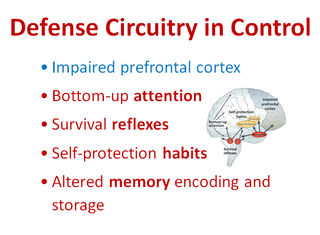Sexual Abuse
In Most Sexual Assaults, “Defense Circuitry” Runs the Show
Key to understanding and supporting survivors, and doing great investigations.
Posted December 19, 2017
When I teach military professionals the basic neurobiology of sexual assault trauma, I’m mainly connecting the dots and turning on those proverbial light bulbs in their heads.

They already know that people respond to gunfire and explosions with reflex and habit behaviors (hopefully effective habits learned in combat training). Most already know, all too well from their own combat experiences and after-action reviews, just how incomplete traumatic memories can be.
When it comes to sexual assault, though, many haven’t yet thought about this: Thanks to how our brains evolved, people respond in the same basic ways to an acquaintance sexually assaulting them as they do to enemy fire and, going back to where it all started, to being attacked by a large predator that’s hell-bent on eating them.
Natural selection has given our brains a defense circuitry to defend against all manner of attacks and high-stress situations. And that circuitry is running the show during most sexual assaults, just as it is during military combat and other experiences of attack or extreme stress.
A few clarifications: Not every sexual assault, as it’s happening, involves severe stress or trauma. But most do, as do many experiences of sexual harassment, and that’s what I’m focusing on here. Second, the brain isn’t a computer, but most neuroscientists see it as composed of “circuitries” (or “networks”), that is, collections of brain areas that work together to perform certain functions. Third, the old term “fear circuitry” is on the way to being replaced by “defense circuitry,” because different brain circuitries underlie subjective experiences (e.g., feeling afraid) and objective behaviors (e.g., freezing), and because researchers can’t ask animals if they’re afraid but can certainly measure defensive behaviors and brain activity.
You may not have heard of the defense circuitry before, but you’ve probably heard of the amygdala. It’s a small, almond-shaped part of the brain with subregions that receive and send information from and to many other brain areas and circuitries. Contrary to conventional wisdom, the amygdala is not the brain’s “fear center.” New research shows it may not even detect threats. The amygdala can, however, have big impacts on stress-related behaviors and memories, and it’s definitely a key component of the defense circuitry.
So let’s remember the “defense circuitry,” even if it doesn’t sound as cool as “amygdala.”
Importantly, we don’t need to know exactly which parts of the defense circuitry perform exactly which functions and have exactly which effects on behavior and memory. (Neuroscientists can worry and fight about those details. If you’re interested, the references below give entry into recent debates.)
It’s much more helpful to know some key facts: The defense circuitry is always on, scanning for danger. When an attack is detected or stress is high, it can rapidly dominate the brain, including by impairing the rational prefrontal cortex and by controlling attention, shifting behavior to reflexes and habits, and determining what gets into memory.
For example, as I’ll explain in a future post, research on animals and humans has shown that stress shifts the brain to dependence on behaviors of the habit circuitry. Again, this is something the military totally understands, and why combat training involves repeatedly loading, cleaning, and firing weapons and repeatedly practicing combat tactics, so those behaviors get burned into the habit circuitry.
Once we’ve absorbed these key facts about the defense circuitry, we won’t be surprised when an intelligent woman says it never occurred to her, while being raped, to yell for her roommate. We’ll know it’s likely that her prefrontal cortex was impaired. We won’t be surprised if a Navy recruit, while being held down and sodomized in a “hazing incident,” responded just how he always did when his stepfather beat him up. We’ll know that his brain’s defense circuitry is perfectly capable of cueing up, in a flash, those old habits of submission.
Nor will we misjudge a woman who, while held down on a bed in a state of confused terror, fell back on polite habits she has long used to successfully resist unwanted advances from men who aren’t rapists. When she recalls repeatedly saying, “My boyfriend will find out,” until finally collapsing in defeat, we won’t be puzzled by the apparent disconnect between the words she was speaking and the shock and fear she was feeling. We won’t assume from her polite words that, “actually,” she had “mixed feelings” at the time, and only later “called it rape” because she was afraid her boyfriend would find out.
Instead, we won’t make such assumptions. If we’re an investigator who understands these things, we’ll ask non-leading and non-judgmental questions, listen with genuine curiosity and willingness to learn something new about how people can respond to sexual assault, and then objectively piece together her recollections with all of the other available evidence.

Outdated approaches to investigating push survivors for sequential narratives, even when their memories aren’t recalled that way. They expect accounts of clearly rational and strategic behavior in the midst of being attacked. They lead to misunderstanding what happened, re-traumatizing survivors, and letting perpetrators get away with it (and do it again).
In contrast, investigators who understand how brains function in traumatic situations listen for the moment the attack was detected by the victim’s defense circuitry, perhaps accompanied by a brief “freeze” response. They know that’s a key moment in most sexual assaults, when brain functioning suddenly and radically changes, with major consequences for thinking, behavior, and memory. They understand why only some details of the experience (e.g., “central details” the defense circuitry gave the most attention and significance, whether a hand on the throat or a spot on the wall) were burned into memory, while other details (that were “peripheral” for the victim but may be central to the investigation) never got encoded or faded soon thereafter.
In summary, knowing what happens when the defense circuitry detects an attack and rapidly dominates brain functioning enables us to have realistic expectations about victims’ behaviors and memories. We can understand that those behaviors and memories, however confusing and implausible they may seem at first, are normal, brain-based responses to being attacked, whether sexually or physically, by an enemy or anyone else. And we can respond to every account of someone reporting sexual assault with a mind and heart that are well-prepared, compassionate, and truly objective, not prone to misinterpretations and misjudgments of their behaviors and memories.
In my teaching I’ve found that, along with survivors of sexual assault, military professionals and police officers are the quickest studies. Because they too have experienced what happens when their defense circuitry runs the show, they can suddenly connect all kinds of dots they’d never connected before.

In future posts I’ll explain all of this in more detail and unpack those bullet points in the image to the left. In the meantime, you can check out Sexual Assault & the Brain on my website, my brief writings on why many sexual assault victims don’t fight or yell and have fragmentary memories, and my engaging in-depth video, Neurobiology of Trauma & Sexual Assault. (All published before the most recent amygdala research and before I replaced “fear circuitry” with “defense circuitry.”)
References
Amir A., Lee S. C., Headley D. B., Herzallah M. M., & Pare, D. (2015). Amygdala signaling during foraging in a hazardous environment. The Journal of Neuroscience, 35, 12994-13005.
Arnsten, A.F.T. (2009). Stress signalling pathways that impair prefrontal cortex structure and function. Nature Reviews Neuroscience, 10, 410-422.
Arnsten, A. F. (2015). Stress weakens prefrontal networks: molecular insults to higher cognition. Nature Neuroscience, 18, 1376-1385.
Barrett, L. F. (2017). The theory of constructed emotion: An active inference account of interoception and categorization. Social Cognitive and Affective Neuroscience, 12, 1-23.
Choi, J. S., & Kim, J. J. (2010). Amygdala regulates risk of predation in rats foraging in a dynamic fear environment. Proceedings of the National Academy of Sciences, 107, 21773-21777.
Diamond, D., et al. (2007). The temporal dynamics model of emotional memory processing: A synthesis on the neurobiological basis of stress-induced amnesia, flashbulb and traumatic memories, and the Yerkes-Dodson Law. Neural Plasticity, 60803, 1-33.
Kozlowska, K., et al. (2015). Fear and the defense cascade: Clinical implications and management. Harvard Review of Psychiatry, 23, 263-287.
LeDoux, J. E., & Pine, D.S. (2016). Using neuroscience to help understand fear and anxiety: A two-system framework. American Journal of Psychiatry, 173, 1083-1093.
Mather, M., Sutherland, M. R. (2011). Arousal-biased competition in perception and memory. Perspectives in Psychological Science, 6, 114-133.
McGaugh, J. L. (2015). Consolidating memories. Annual Review of Psychology, 66, 1-24.
Pare, D., & Quirk, D. J. (2017). When scientific paradigms lead to tunnel vision: lessons from the study of fear. npj Science of Learning, 2, 1-8.
Pellman, B. A., & Kim, J. J. (2016). What can ethobehavioral studies tell us about the brain’s fear system? Trends in Neurosciences, 39, 420-431.
Schwabe, L. (2017). Memory under stress: From single systems to network changes. European Journal of Neuroscience, 45, 478-489.
Touroutoglou, A., Lindquist, K. A., Dickerson, B. C., & Barrett, L. F. (2017). Intrinsic connectivity in the human brain does not reveal networks for 'basic' emotions. Social Cognitive and Affective Neuroscience, 10, 1257-1265.




